Questions - introduction/es: Difference between revisions
From LimeSurvey Manual
Maren.fritz (talk | contribs) (Created page with "*'''Tipo de pregunta:''' Determina el tipo de respuesta que permite la encuesta. Vea la sección tipos de preguntas para obtener una descripción de las...") |
Maren.fritz (talk | contribs) (Created page with "*'''¿Otro?:''' Esta opción sólo se puede utilizar con ciertos tipos de preguntas. Si está habilitada, la pregunta incluirá como posible respuesta una opción/cuadro de re...") |
||
| Line 55: | Line 55: | ||
*'''Validación:''' Esta función está disponible en todas las preguntas de tipo texto y numéricas. Puede utilizar [[Uso de expresiones regulares|expresiones regulares]] estándar en este campo para validar las respuestas a la pregunta y, si las respuestas no se validan con esta expresión, se le pedirá al usuario que vuelva a intentarlo antes de poder hacerlo. progresar más. | *'''Validación:''' Esta función está disponible en todas las preguntas de tipo texto y numéricas. Puede utilizar [[Uso de expresiones regulares|expresiones regulares]] estándar en este campo para validar las respuestas a la pregunta y, si las respuestas no se validan con esta expresión, se le pedirá al usuario que vuelva a intentarlo antes de poder hacerlo. progresar más. | ||
*''' | *'''¿Otro?:''' Esta opción sólo se puede utilizar con ciertos tipos de preguntas. Si está habilitada, la pregunta incluirá como posible respuesta una opción/cuadro de respuesta adicional "otra", que el participante de la encuesta puede seleccionar si no está satisfecho con las opciones de respuesta predefinidas. | ||
*''' | *'''Obligatorio ?:''' Esta configuración le permite solicitar a los participantes de la encuesta que respondan todas las preguntas obligatorias antes de poder pasar a la siguiente pregunta. Tenga en cuenta que para una pregunta de clasificación, todos los elementos deben clasificarse. | ||
*'''Condition''': This is the ExpressionScript equation that specifies the question conditions. If it evaluates to true (1), the question will be displayed to the survey participant; otherwise it is hidden and since it is irrelevant, data for that question is NULLed in the database. Details about how to use this option can be found in the [[ExpressionScript - Presentation|ExpressionScript]] wiki section. | *'''Condition''': This is the ExpressionScript equation that specifies the question conditions. If it evaluates to true (1), the question will be displayed to the survey participant; otherwise it is hidden and since it is irrelevant, data for that question is NULLed in the database. Details about how to use this option can be found in the [[ExpressionScript - Presentation|ExpressionScript]] wiki section. | ||
Revision as of 14:52, 6 September 2023
Introducción
Una vez que haya creado sus grupos de preguntas, puede comenzar a agregar preguntas dentro de cada grupo. Hay varias formas de hacerlo. A continuación se presentan dos soluciones:
- Puede agregar preguntas desde el menú de estructura de la encuesta;
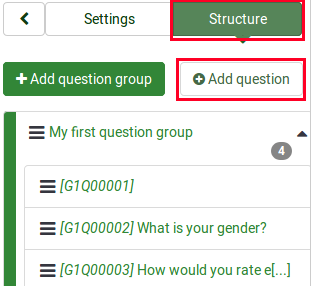
- Acceda a un grupo de preguntas y busque el botón de acción rápida agregar pregunta;
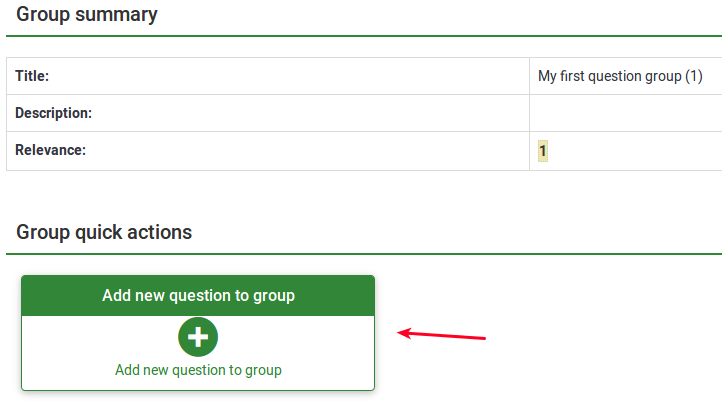
Descripciones de campos
Al agregar una pregunta, se le preguntará sobre los textos código de pregunta, pregunta y ayuda, y las opciones generales de pregunta:
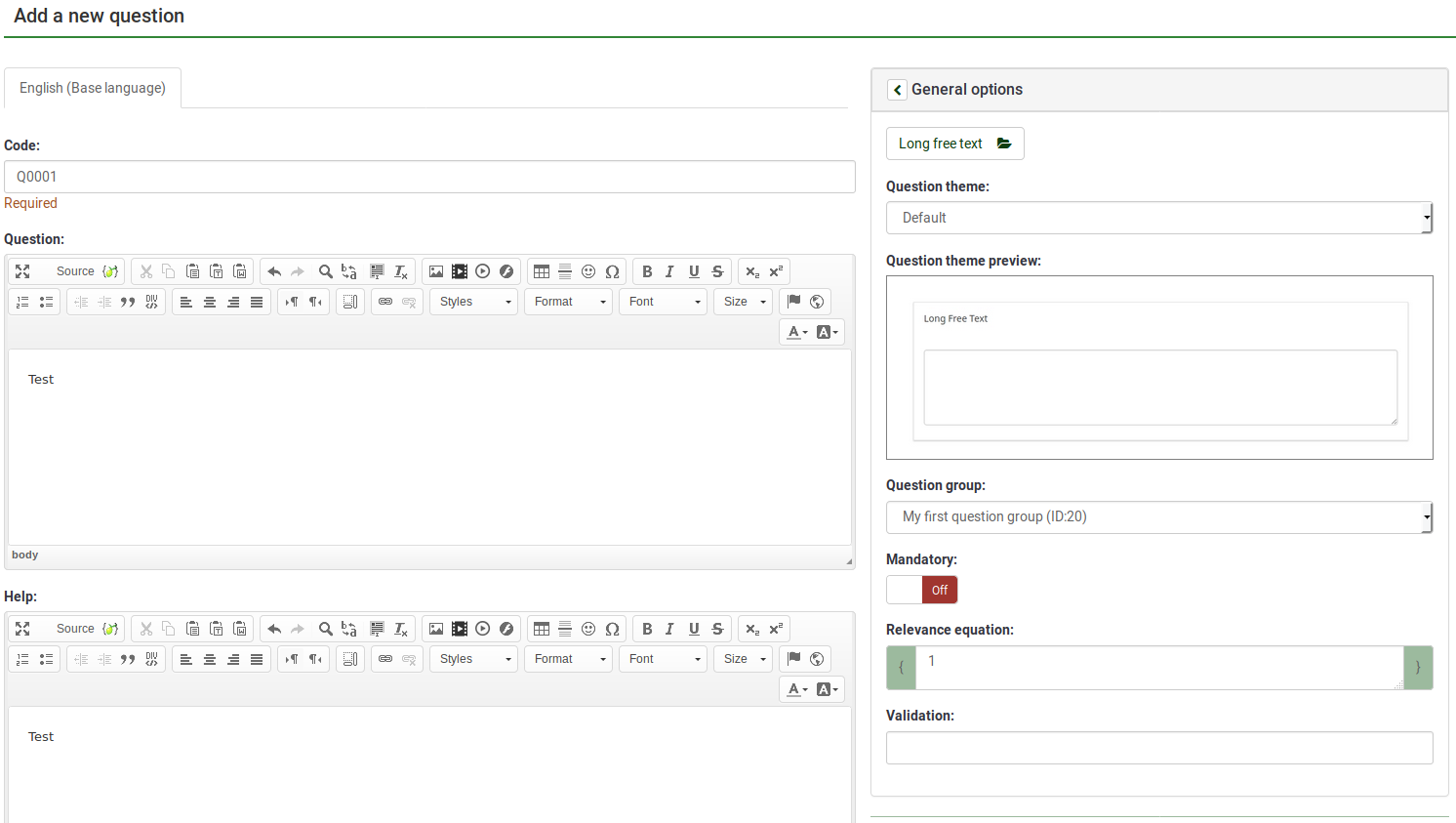
- Código de pregunta: Representa el ID, número o código de la pregunta que se utiliza para una identificación rápida. Este campo normalmente no se muestra a las personas que responden la encuesta a menos que se especifique en el panel Presentación - Mostrar número y/o código de pregunta. Es especialmente útil si desea utilizar la Función de evaluaciones de LimeSurvey y/o el ExpressionScript.
- Pregunta: Esta es la pregunta real que se hace. No hay un límite real para la extensión de la pregunta aquí; sin embargo, si desea explicar cómo completar la pregunta, déjelo para el campo "Ayuda". Se puede utilizar código HTML, por ejemplo, para incluir imágenes:
<img src="http://www.yourdomain.com/yourpics/pic.jpg">
- Ayuda: Este es un campo opcional. Es útil si una pregunta necesita alguna explicación o si desea explicar cómo debe responderse. Cuando coloca texto en este campo, aparece un icono de "signo de interrogación" en las pantallas de entrada de la encuesta con el texto de ayuda justo al lado.
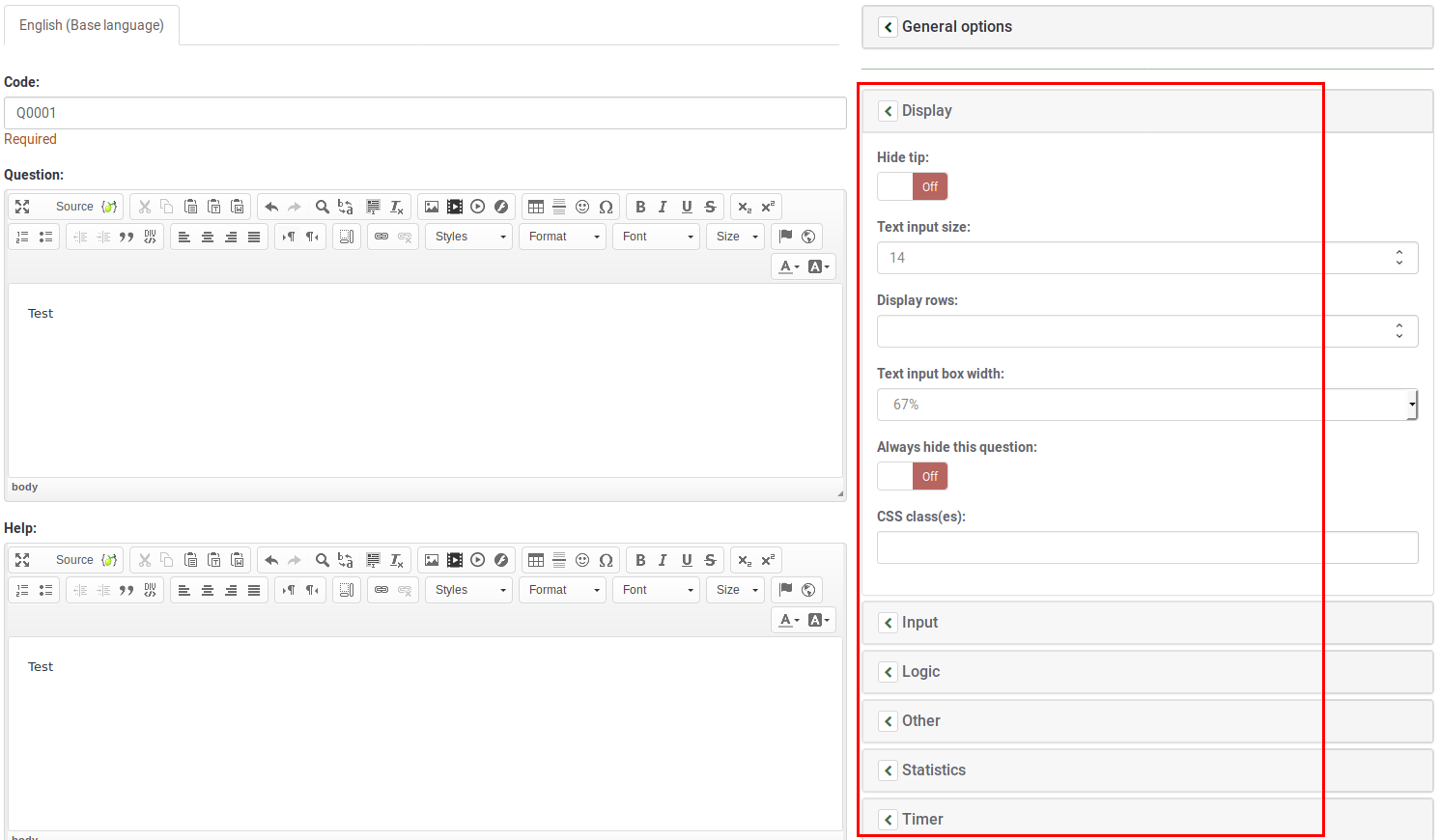
Opciones generales
Se muestran diferentes pestañas en la parte derecha de la pantalla. La más básica e importante es la pestaña Opciones generales. Las siguientes configuraciones de preguntas se pueden cambiar desde aquí:
- Tipo de pregunta: Determina el tipo de respuesta que permite la encuesta. Vea la sección tipos de preguntas para obtener una descripción de las distintas opciones disponibles.
- Grupo de preguntas: Para cambiar el grupo de preguntas de una pregunta, seleccione de la lista desplegable el grupo.
- Validación: Esta función está disponible en todas las preguntas de tipo texto y numéricas. Puede utilizar expresiones regulares estándar en este campo para validar las respuestas a la pregunta y, si las respuestas no se validan con esta expresión, se le pedirá al usuario que vuelva a intentarlo antes de poder hacerlo. progresar más.
- ¿Otro?: Esta opción sólo se puede utilizar con ciertos tipos de preguntas. Si está habilitada, la pregunta incluirá como posible respuesta una opción/cuadro de respuesta adicional "otra", que el participante de la encuesta puede seleccionar si no está satisfecho con las opciones de respuesta predefinidas.
- Obligatorio ?: Esta configuración le permite solicitar a los participantes de la encuesta que respondan todas las preguntas obligatorias antes de poder pasar a la siguiente pregunta. Tenga en cuenta que para una pregunta de clasificación, todos los elementos deben clasificarse.
- Condition: This is the ExpressionScript equation that specifies the question conditions. If it evaluates to true (1), the question will be displayed to the survey participant; otherwise it is hidden and since it is irrelevant, data for that question is NULLed in the database. Details about how to use this option can be found in the ExpressionScript wiki section.
- Encrypted: This setting is only available for some question types and determines if the saved response data is encrypted in the database. This gives an additional layer of security if your database gets hacked. However, it has some minor drawbacks, as you will not be able to search for partial texts in the response view and encrypting/decrypting also requires additional server resources.
- Save as default values: This setting allows you to save the settings of the current question type as default settings for new questions. If you set it to 'On', it will save the default values, then automatically reset to 'Off' after you saved.
- Clear default values: With this setting, you can reset any default values saved by the function 'Save as default values' and revert to system default values. If you set it to 'On', it will reset the default values, then automatically reset to 'Off' after you saves.
Importing a question
The following steps demonstrate how to import a question into a survey.
(1) From within a survey, click the Structure tab.
(2) From the Create question page, click Import a question at the top of the page.
The Import a question options will be displayed.
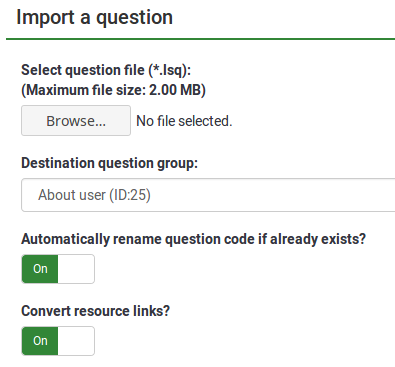
(3) Click Browse and select the .lsq file (which is the LimeSurvey question-type format).
(4) Select the Destination question group that you want to add the imported question into.
(5) Choose whether or not you would like to Automatically rename the question code if it already exits. If the question code already exists, enable this option to use another question code. You can also have two questions that use the same question code. However, some issues might appear if you use more complex LimeSurvey options such as the ExpressionScript or when you work with the exported data in R or SPSS (qcode becoming a value label).
(6) Choose whether or not to Convert resource links. This option is usually used together with the ExpressionScript to create advanced question types. If you use them together, complex branching, assessments, validation, and/or tailoring can be done.
(7) Click Import located on the upper right part of the screen.
The Question import summary will be displayed.
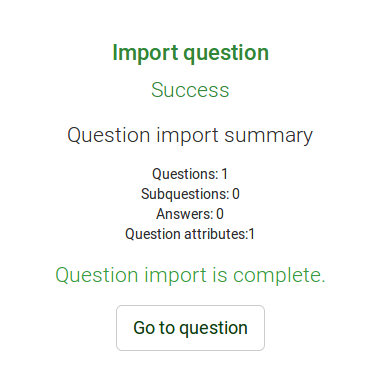
Information from survey participants table
You can insert information or text from the survey participants table into your question so that it can show context related information. For LimeSurvey to do this, the survey needs to be set as not anonymous (i.e: tracked) and it needs to have a survey participants table created.
The following placeholders can be used within a question:
| {TOKEN:FIRSTNAME} | inserts the value from the "firstname" field located in the survey participants table |
| {TOKEN:LASTNAME} | inserts the value from the "lastname" field located in the survey participants table |
| {TOKEN:EMAIL} | inserts the value from the "email" field located in the survey participants table |
| {TOKEN:ATTRIBUTE_1} | inserts the value from the "attribute_1" field located in the survey participants table |
| {TOKEN:ATTRIBUTE_2} | inserts the value from the "attribute_2" field located in the survey participants table |
To use any of the placeholders from above, you must type it/them as written above in the question field text. For example:
Hello {TOKEN:FIRSTNAME}. We sent an email to you using this address {TOKEN:EMAIL}.
If you wish to further customize your questions, use the [[ExpressionScript - Presentation|ExpressionScript]]. For example, if you wish to make use of the tailoring technique, type in:
<syntaxhighlight lang="php">What do you as a {TOKEN:ATTRIBUTE_1} think about your {if(TOKEN:ATTRIBUTE_1=='worker','bosses','workers')}?
You may also use JavaScript to achieve further question customization. First, you have to allow JavaScript to be used when setting up questions. This can be achieved by deactivating the XSS filter from the global settings of your LimeSurvey installation. However, deactivating this option is not always a good idea - read the following wiki section for further information. Question tailoring via JavaScript:
Hello {TOKEN:FIRSTNAME}. We sent an email to you using this address {TOKEN:EMAIL}. Is this correct?
What do you as a {TOKEN:ATTRIBUTE_1} think about your
<script type="text/javascript" language="Javascript">;
var job='{TOKEN:ATTRIBUTE_1}';
if (job=='worker') {
document.write ('bosses')
} else {
document.write('workers')
}
</script>
?
Information from previous answers
LimeSurvey allows survey administrators to insert an answer(s) from the previous question(s) into the text of a question:
- You can refer to answers on the same page and even dynamically update tailored messages as responses change on the page.
- You can use question code naming - for more details, see the ExpressionScript documentation.
A wizard has been integrated in the WYSIWYG HTML editor (FCKeditor), so that you can easily insert previous question/answer codes. This plugin is called LimeReplacementFields.
In order to use this feature in the FCKeditor:
(1) Click the "lime between brackets" icon.
(2) Select a question from the select box.

Only answers from previous pages are displayed.
Styling questions
It is possible to edit the question layout/design with CSS using the theme editor.
